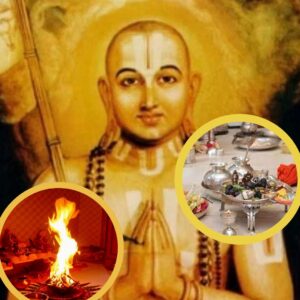
Saint Ramanuja’s gift of the Ijya Puja ritual
Saint Ramanuja was a revolutionary Acharya-saint who lived one thousand years ago. He took a keen interest in studying ancient Pancharatra Agama texts. He revised extant temple rituals to fall in line with these Agama texts. Ramanuja also created a simple Puja ritual, the Ijya Puja, which brought the benefit of a fire ritual to a commoner.
This post answers the following questions.
- Why did Ramanuja recommend the Ijya-style Puja for Vishnu?
- What is Ijya? What is its connection to Vedic rituals, specifically Ishti?
- Does the Ijya Puja differ from other styles, vis-a-vis the Puja ritual for Shiva?
The Ishti Fire ritual
Firstly, the popular word Yagna refers to a Vedic fire ritual. Secondly, Vedic scholars classified Yagnas broadly based on their offerings. Chanting of a mantra that invites or praises a deity accompanies simpler Havis-Offering in an Ishti-style Yagna. Svaha chants accompany the pouring of the Havis-Oblations in an Ahuti-style yagna. Ijya refers to any performance that adheres to Ishti principles.

Agama texts explain the logic behind the steps in a Puja. The ancient Agama texts’ authors were Vyasa’s contemporaries. They borrowed procedures from Vedic rituals and adapted them for temple worship. Some authors wrote texts for worshipping Vishnu and some for other deities like Shiva. Pancharatra Agama text describes the logic behind Vishnu’s worship.
Historically people kept small stones from sacred spots in rivers and performed Puja to these at home. Even today, people worship Vishnu in a Saligram stone from the Gandaki River and Shiva in a Bana lingam stone from the Narmada River. They offer Tulasi leaves for Vishnu, and Bhel leaves for Shiva. Agama texts teach us about such choices. They also tell us less-known facts, such as Vishnu’s Puja is like a Yagna, and objects in Shiva’s Puja honor his rulership over the five Bhuta-Elements. What is the connection between Vishnu and Yagna??
Connection between Vishnu and Yagna
Saint Ramanuja selected the famous mantra that connects Yagna with Purusha, the divine being. He taught the Ijya style Puja using this mantra as its framework to his followers. The Purusha Sukta mantra recounts the creation sequence through the mechanism of Yagna.
The Yagna of Devas
Devas began the first Yagna before creatures arose on Earth. The seasons became the starter material. Twenty-one life-force impulses lay in readiness within nature when Devas began the Yagna. They served as the Samit, the kindling sticks for the Yagna. Devas stabilized the Yagna with seven other impulses for the Paridhi blocks. However, Purusha was the only final viable Havis. Purusha arose again as the result of the final Havis. Devas continued the Yagna with this Purusha. The Yagna took on a global scope.
This Yagna filled mother nature with powerful potencies. These potencies pushed evolution forward. Prakriti, mother nature, could now use the life force impulses already filling the atmosphere. The locomotor-sensory organs of creatures began developing out of the life force impulses. Animals began to appear gradually on land and air. Rig, Yajur, and Saman Hymns resonated subtly in the Akashic space before horses, cows, and sheep emerged. Devas receded to the domain of Naka at the arrival of creatures on Earth.
Material Yagnas, Ishti Yagna
Rishis began to meditate and download the hymns resonating in the Akashic space around the Earth. They cognized the mechanism of Yagnas for the first time. Rishis discovered Ghee, fruits, and others as Havis in material Yagnas. They recognized the continuing role of Purusha in existence and declared Purusha to be the unborn potentiality. Purusha awaits eternally to be born in every generation of creatures.
Yagna became a powerful mechanism to infuse the unborn Purusha’s power into material existence. Generations of Rishis explored several ways to perform Yagnas. Vyasa chose five prototypes for the Kali Era from an enormous collection of Yagnas. The Agama authors structured Puja rituals based on those. Millennia later, Ramanuja developed the Ijya Puja ceremony from the Ishti Yagna for the followers of the Vaishnava tradition. The Saligrama stone representing Vishnu, the Purusha, is used in the Ijya Puja.
Ardhanai, Thirumanjanam, Sri Vaishnava Puja are the other names
Paridhi refers to the wood blocks which are placed as stakes into the ground to mark the boundary of Yagna. They are essential elements in the Yagna ground.
Yes, Vaikhanasa is another popular Agama.
It is true that the great Kings in India began the construction of larger temple complexes with granite and stone more recently. Earlier structures were made of wood and brick. These did not survive. They were replaced by well-built temples over the centuries. The deity within the temple in earlier times was also made of wood. Uncarved sacred stones were also popular as deities earlier.
Related Posts
Worship sites before the advent of temples